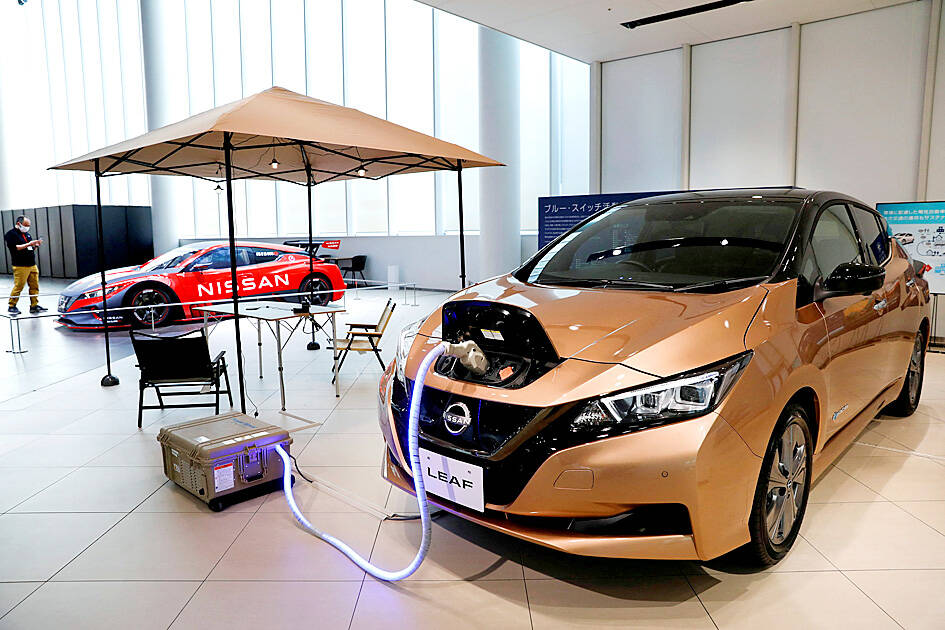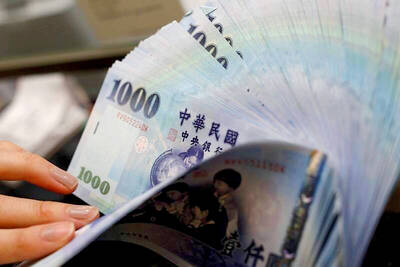Toyota Motor Corp saw a slight drop in global sales last month due to lingering effects of the COVID-19 pandemic and a chronic shortage of semiconductors for automobiles, the Japanese automaker said.
Sales, including Daihatsu Motor Co and Hino Motors Ltd, fell 3.6 percent from a year earlier to 795,847 vehicles, while production rose 8.4 percent to 819,727 units, the world’s No. 1 automaker said yesterday, adding that the shortages were worse a year earlier, resulting in an output increase last month.
The numbers come about a month before Lexus International Co president Koji Sato is set to take over as Toyota CEO in April, as production recovers from pandemic lockdowns, supply chain problems and a stubborn component shortage.

Photo: Reuters
Domestic sales and production rose year-on-year for the third month in a row, with Japan sales climbing 18 percent to 186,998 units, Toyota said.
The company’s third-quarter profits surpassed estimates, but the automaker kept its conservative outlook for the fiscal year ending March in line with its previous forecast for operating profit of ¥2.4 trillion (US$17.62 billion).
Separately, Nissan Motor Co is accelerating efforts to electrify its vehicle models in Europe and Japan, as a growing list of nations impose deadlines to phase out gasoline-powered vehicles and competition mounts from domestic and overseas rivals.
The Japanese automaker now expects 98 percent of its sales in Europe to be hybrid or fully electric in fiscal 2026, up from its prior target of 75 percent set in November 2021, the Yokohama-based company said in a statement yesterday.
For its home market, it anticipates 58 percent electrified vehicle sales, up from 55 percent.
Nissan, which released the Leaf — the world’s first mass-produced battery electric vehicle (EV) — in 2010, is now seeking to catch up with Tesla Inc in the US and Volkswagen AG in Europe.
The Japanese auto manufacturer has committed ¥2 trillion to electrify more of its lineup and make battery-powered vehicles a key driver of future growth.
Nissan chief operating officer Ashwani Gupta said in a briefing that the company plans to introduce 27 electric models, including 19 EVs, by fiscal 2030, up from the previously planned 23 models and 15 EVs.
As a result, 55 percent of Nissan’s sales, including for the Infiniti brand, are expected to be from EVs, the automaker said.
EVs comprised 13 percent of global sales in the third quarter of last year.
Nissan plans to fully localize US EV production and comply by 2026 with Inflation Reduction Act (IRA) subsidy requirements, including the decarbonization of its Tennessee plant, Gupta said.
The law, passed in the US last year, provides generous incentives for selling EVs, but has stringent requirements on manufacturing and supply-chain sourcing. The company is targeting 40 percent of sales to be EV-only by fiscal 2030.
“The IRA is giving us the opportunity to speed up electrification in the United States,” Gupta said. “We have completed the path to comply with the IRA.”
Nissan cut its electrification target in China to 35 percent from 40 percent in fiscal 2026. In China’s market for battery-powered EVs, Gupta said local brands are “leading the way,” and as such Nissan is to release an EV SUV in 2024.
“This is the new way Nissan is going to work in China, for China,” he said.

Merida Industry Co (美利達) has seen signs of recovery in the US and European markets this year, as customers are gradually depleting their inventories, the bicycle maker told shareholders yesterday. Given robust growth in new orders at its Taiwanese factory, coupled with its subsidiaries’ improving performance, Merida said it remains confident about the bicycle market’s prospects and expects steady growth in its core business this year. CAUTION ON CHINA However, the company must handle the Chinese market with great caution, as sales of road bikes there have declined significantly, affecting its revenue and profitability, Merida said in a statement, adding that it would

Greek tourism student Katerina quit within a month of starting work at a five-star hotel in Halkidiki, one of the country’s top destinations, because she said conditions were so dire. Beyond the bad pay, the 22-year-old said that her working and living conditions were “miserable and unacceptable.” Millions holiday in Greece every year, but its vital tourism industry is finding it harder and harder to recruit Greeks to look after them. “I was asked to work in any department of the hotel where there was a need, from service to cleaning,” said Katerina, a tourism and marketing student, who would

i Gasoline and diesel prices at fuel stations are this week to rise NT$0.1 per liter, as tensions in the Middle East pushed crude oil prices higher last week, CPC Corp, Taiwan (台灣中油) and Formosa Petrochemical Corp (台塑石化) said yesterday. International crude oil prices last week rose for the third consecutive week due to an escalating conflict between Israel and Iran, as the market is concerned that the situation in the Middle East might affect crude oil supply, CPC and Formosa said in separate statements. Front-month Brent crude oil futures — the international oil benchmark — rose 3.75 percent to settle at US$77.01

RISING: Strong exports, and life insurance companies’ efforts to manage currency risks indicates the NT dollar would eventually pass the 29 level, an expert said The New Taiwan dollar yesterday rallied to its strongest in three years amid inflows to the nation’s stock market and broad-based weakness in the US dollar. Exporter sales of the US currency and a repatriation of funds from local asset managers also played a role, said two traders, who asked not to be identified as they were not authorized to speak publicly. State-owned banks were seen buying the greenback yesterday, but only at a moderate scale, the traders said. The local currency gained 0.77 percent, outperforming almost all of its Asian peers, to close at NT$29.165 per US dollar in Taipei trading yesterday. The